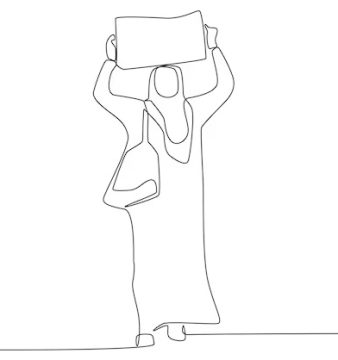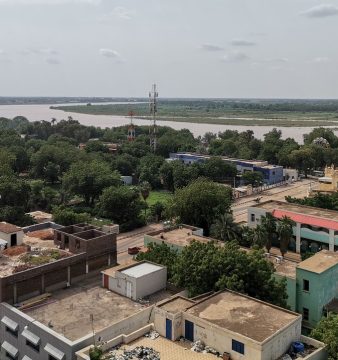Inside Al Qeyada
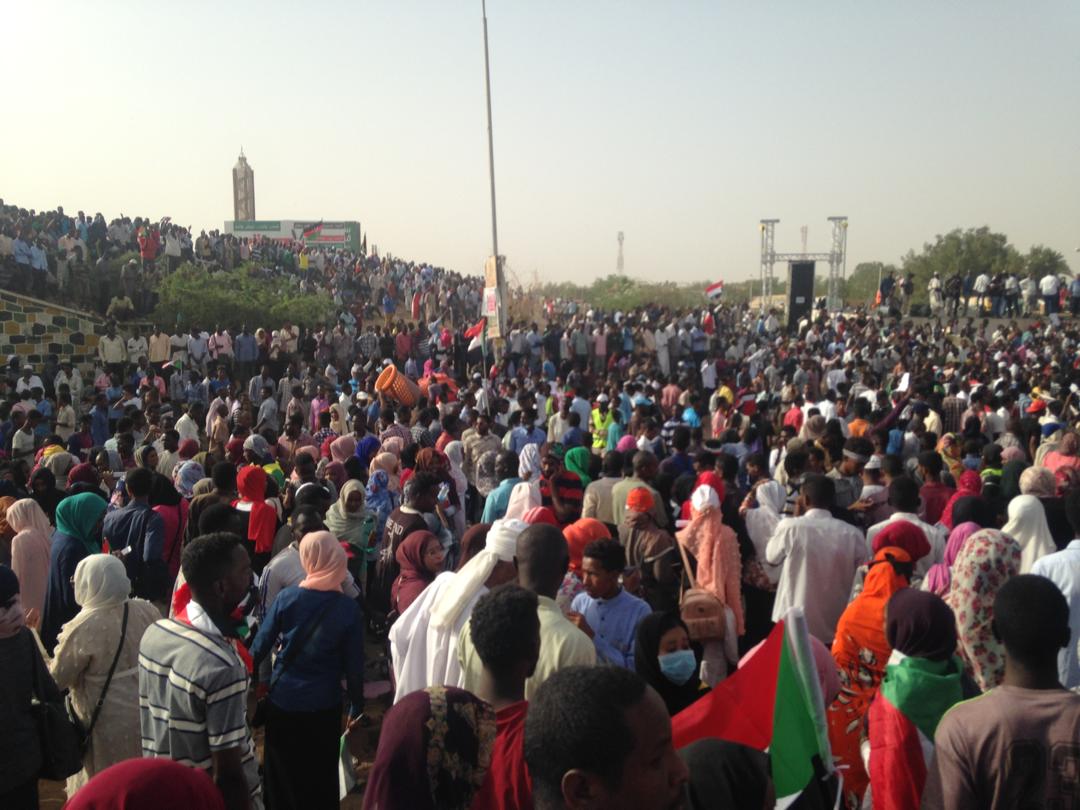
The Sudanese uprising begin on 19 December 2018 and continues to this day. The protests began in smaller numbers in cities outside the capital and found their way in larger numbers in Khartoum and across the country. Today, millions gather around the headquarters of the Sudanese Armed Forces (SAF), in what is now known as Al Qeyada.
The sit-in started on 6 April. It was called ‘Million of 6 April’ but people estimate the number was much bigger than a million. The Sudanese Professionals Association (SPA) called for the march to the headquarters of SAF, which overnight turned into a sit-in in Al Qeyada St, sending their message loud and clear. Al Qeyada St is significant in that it is surrounded by many government buildings including SAF, Ground forces headquarters, Naval forces headquarters and ministry of defence. the place was crowded with officers and police, the NISS couldn’t use it’s ways of repression there.
The successful mass sit-in led to the overthrow of Omar Al Bashir on 11 April. But when Al Bashir stepped down, former First Vice President of Sudan and Chairman of Transitional Military Council (TMC,) Ahmed Awad Ibn Auf, came to power and announced a Transitional Military Council will rule for two years, both strongly rejected by protesters and the mass sit-in continued. The people are refusing to accept another military rule. Since the protests began in December 2018, protesters demanded the fall of not only Al Bashir but of the whole military regime and ruling National Congress Party (NCP). A day later, Ibn Auf stepped down bringing into power yet another military man in to power, Lieutenant General Abdel Fattah Abdelrahman Burhan.
According to SPA’s declaration:
‘Ending war and building peace, to clarify the names of the arrested from the fallen regime and where are they being held, dissolution of the National Congress Party and the devolution of its property to the country, release all of the political figures, including all officers and soldiers who tried to defend the people.’
There are many university students joining the sit-in, gathering near Al Qeyada on a specific time and then moving together. Participating universities include University of Khartoum, Sudan University of Science and Technology, National Ribat University, National University, Nile Valley University, Blue Nile University and more.
This is why the Sudan uprising or revolution is considered a youth’s revolution, driven by the youth for the youth.
Getting in
Al Qeyada St is a main street with proximity to several other main streets including University of Khartoum St, Armed Forces bridge, Blue Nile Bridge, Ebed Khatim St, Burri’s Roundabout and Africa St, making it convenient to many people to get to Al Qeyada.
There are many ways to get into Al Qeyada. All the nearby streets are convenient except Africa St, which takes drivers in a different direction towards Ebed Khatim St, Burri Roundabout or Al Jamhuriya St.
In a sit-in, people stay in one place, no matter what happens, and do not leave until their demands are met. Therefore, to ensure people stay, Al Qeyada has to be safe and secure, and the protesters are catered for.
To help organise the sit-in, every protester contributed one way or another. People were divided into teams, each with specific tasks and responsibilities to make sure all the protestors are safe, secure and satisfied.
The first days of the sit-in, some people were found carrying weapons from pocket knives to butcher knives. As a result, a security team was created to ensure the safety and security of protesters inside Al Qeyada. A checkpoint was established at each entry point where people are checked before entering Al Qeyada, These checkpoints are distributed in all of the access streets with at least three checkpoints in any street surrounding Al Qeyada. Females are checked by females and males are checked by males. A person’s entire body is checked by hand and if you are carrying a bag, it gets checked as well.
To block access for the National Intelligence and Security Service (NISS) cars and further secure the street and people, cars are not allowed inside Al Qeyada unless it’s checked and it’s carrying items that need to be delivered inside. Blocking the streets up to Al Qeyada, protesters made mtares or barricades made of rocks, stones, metals and whatever they could. There is a team responsible for the barricades, taking shifts throughout the day to make sure the streets are secure at all times.
I don’t think we will ever be defeated..#اعتصام_القياده_العامه #لم_تسقط_بعد #SudanUprising pic.twitter.com/TEeEGglnT0
— Sarmad Haydar (@ever_lastingag) May 4, 2019
Multiple choice man 😭😭😭😭😭😭😂😂😂😂😂😂✌🏽#اعتصام_القيادة_العامة pic.twitter.com/dMeBVTcesJ
— wxlxx’💎 (@o_walo) April 30, 2019
Food and water
On 6 April, the first day of the sit-in, there wasn’t much organisation or work distribution system. But as hours passed by, people knew what was needed and already began to provide necessities such as food and water, tents, blankets and carpets for those who chose to spend their nights in Al Qeyada. Some of the items were provided from people’s homes, some bought them from nearby supermarkets or shops, and some were donated by supermarkets, shops, companies and organisations. Some people bought the necessities with their own money and some were donated from people in Al Qeyada as part of money collection or donation drive.
Now, food and beverages are constantly available in Al Qeyada. Food and water were mainly provided by donations of people within and outside Al Qeyada. Protesters coming from their homes bring a number of sandwiches and water bottles for other protesters in Al Qeyada. As the days went, restaurants donated food and beverages such as sandwiches to protesters. Mojadedon, a voluntary youth development organisation that works to create solutions to the persistent problems in education, healthcare and sustainable development, played a significant role in providing food and drinks to protesters, setting up a tent in Al Qeyada, preparing food and distributing it to protesters. Soon after, people began to cook and prepare meals inside Al Qeyada. There are many women and families preparing food in large proportions. After the meals are cooked, a team of people distribute meals to people in Al Qeyada.
الحمدلله
25-april
نحن منو؟ ناس الطقة
جايين لي شنو؟ جايبين الطقة
طقة تمام.
مافي كلام. #اعتصام_القيادة_العامة pic.twitter.com/qmapQygjG6— Rawan Atif (@RawanAtif007) April 25, 2019
مسؤول إطعام المعتصمين في الخرطوم فارس النور: أعتقد أن النظام المصري متخوف من إقامة دولة ديمقراطية في السودان. pic.twitter.com/lzDgQKsKl9
— التلفزيون العربي (@AlarabyTV) April 17, 2019
Now, there are many food stalls selling fool, ta’amiya, luqaimat, tea, coffee and more in Al Qeyada.
Healthcare
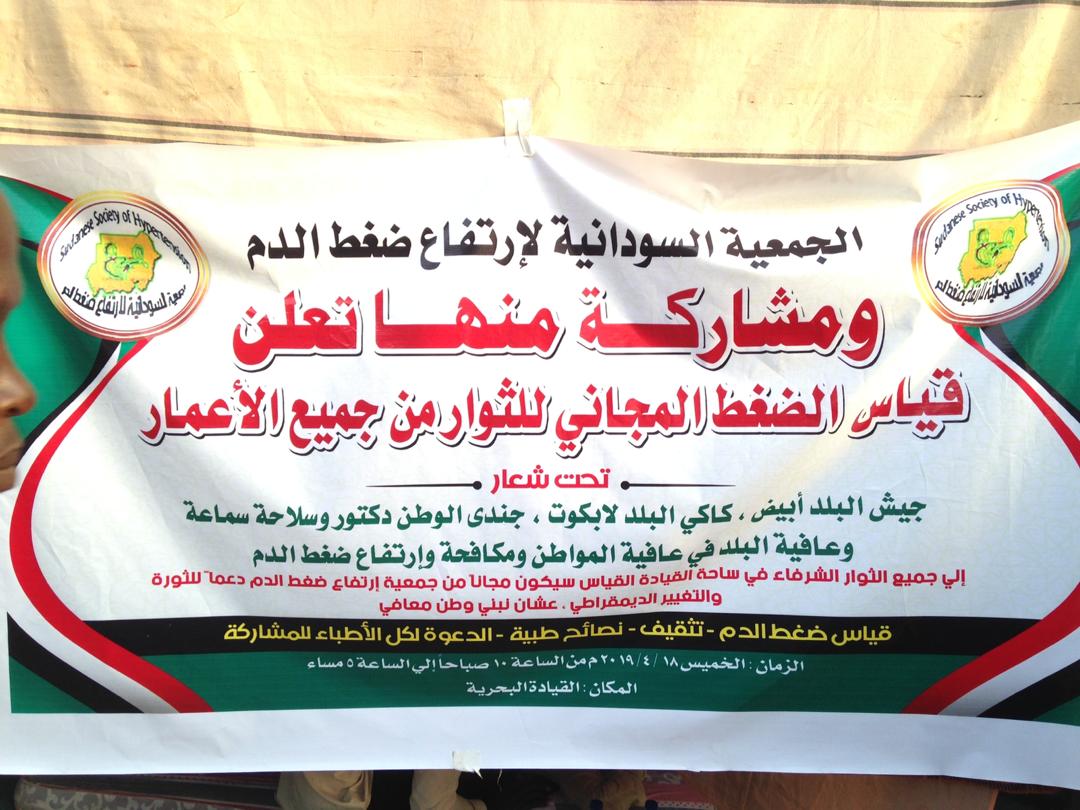
Currently, Sudan is mostly sunny and hot with temperatures that can reach above 40 degrees Celsius with the sun right above your head. Many have experienced heat stroke or stress since the sit-in began. There is a healthcare unit, which consists of a volunteer team of eight doctors, four assistants, two guards and two servicemen. The volunteer team writes down everything patients might need and are responsible for providing food and water as well. After writing a list, they go to another unit, a central healthcare unit where they get everything from.
Since the anti-government protests began in December 2018, many people have witnessed tragic events with some people surviving being shot at or beaten by NISS, and some lost their loved ones and witnessed other protesters, who were chanting alongside him, shot dead. Many have been traumatised, suffering from post-traumatic stress disorder (PTSD) or other mental disorders.
As volunteers, psychologists stepped in and offered free sessions and treatments for people in Al Qeyada. There is a designated tent with at least six doctors for anyone in need of psychological help. Doctors help those traumatised by the death of relatives, friends or other loved ones, or in many cases, victims of sexual harassment during protests.
The artwork
The Sudan uprising inspired various Sudanese artists and their artworks. Sudanese artists such as designers, musicians, painters, graffiti artists and singers played a major role in using their artwork to express their voice and voices of protesters and martyrs during the uprising. The walls surrounding Al Qeyada are decorated with various artworks. If painters didn’t join in painting the walls, they would paint the Sudanese flag in people’s faces or hands.
We are the revolution ..
And the revolution continues ..
Burri al daraysa pic.twitter.com/wC9J6NvQXY— Alaasatir △⃒⃘ (@alaa_satir) April 18, 2019
“الفن ثورة” #اعتصام_القياد_العامه #تسقط_بس pic.twitter.com/wBQAlf8uoY
— ريم الجعيلي (@ReemAljeally__) April 18, 2019
Taking a walk down the clinic street, at Al Qiyada sit-in..
Truly a revolution of arts ❤️#اعتصام_القيادة_العامة#SudanUprising pic.twitter.com/snby89ege7
— Asadoya (@Queen_Asadoya) May 2, 2019
Home of volunteerism
From the security men to cooks to doctors, most of the people providing services in Al Qeyada are volunteers. There are a team of volunteers and as well as random protesters who clean the campsite in Al Qeyada on a daily basis.
الطفل دا سايق الدرداقة دي و بلم في الاوساخ من الارض، اكيت حاجة ممكن تلاقيك في القيادة#اعتصام_القيادة_العامة pic.twitter.com/ReoWgzi0Gc
— نجم السعد (@FuckNISS) May 4, 2019
There are teachers educating street children and teenagers, teaching them Arabic and English.
المدرسة.. pic.twitter.com/9UmeH1BNbO
— Mustafa (@MustafaFarah_) April 30, 2019
Others have set up a street library for anyone in Al Qeyada to pick up a book and read for free.
الخرطوم وطقسها الأحب ❤
الخرطوم تقرأ علي الدوام والي الابد #اعتصام_القياده_العامه pic.twitter.com/MSj2BeBv7u— Nusaiba Abbas (@NusaibaAli2) May 3, 2019
Since 6 April, Al Qeyada has witnessed music concerts, film screenings, cultural performances, political and social debates and discussions, and more.
Flashlights response to Sudan national anthem.#SudanRevolts
April 25th pic.twitter.com/qGqkEglptJ— AFRODIZIAC (@HikmatAhmad) April 25, 2019
“دفعو لك كم عشان تقلبها دم”
ايمن ماااو#اعتصام_القيادة_العامة pic.twitter.com/FMoIsgniIk
— #المليونية|Aiman|🇸🇩 (@justSDN) April 25, 2019
It is unknown how long the sit-in at Al Qeyada will continue. For now, they’re getting ready to for spending the holy month of Ramadan in Al Qeyada.
Sudanese protesters preparing for Ramadan at the sit-in! #اعتصام_القياده_العامه #مدن_السودان_تنتفض #SudanUprising pic.twitter.com/CCZKILN26D
— X (@AnyXMeans) April 30, 2019
Sudanese protesters preparing for Ramadan at the sit-in
💖#اعتصام_القياده_العامه pic.twitter.com/RTbgIgdzd1— نُـور؛ (@Jour__) May 3, 2019
But if you ask any of the protesters camped in Al Qeyada, they will say they will not leave until their demands are met – a civilian government, not military, in power during the transitional period.
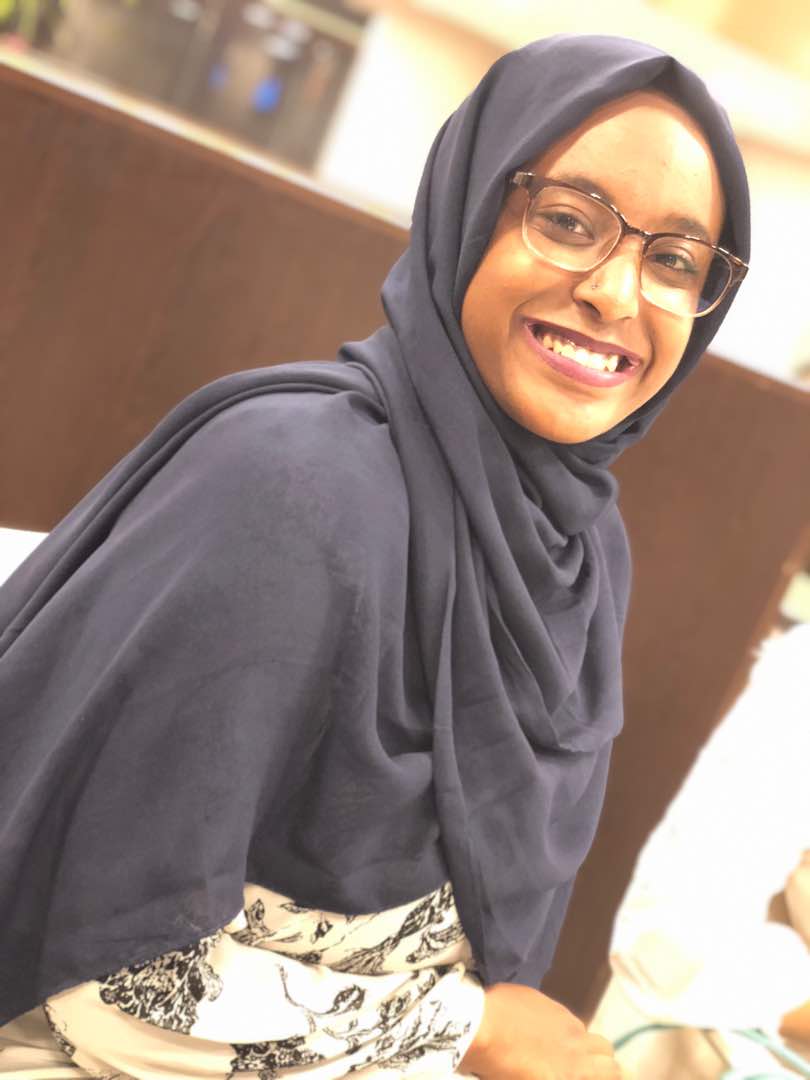 Rawan Abazer is an architect-to-be based in Sudan, trying to put her fingerprints on the world by writing. ‘We put our passion towards traveling and exploring the world into writing,’ she says.
Rawan Abazer is an architect-to-be based in Sudan, trying to put her fingerprints on the world by writing. ‘We put our passion towards traveling and exploring the world into writing,’ she says.

